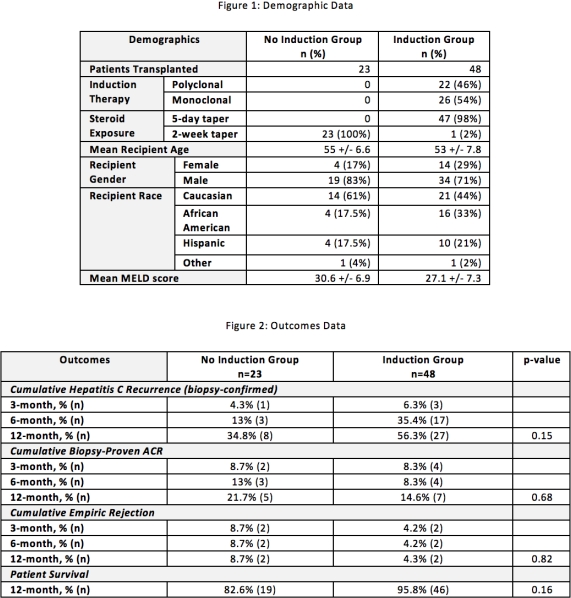Hepatitis C Recurrence after Liver Transplant: A Comparison of Antibody Induction versus No Antibody Induction
S. Patel, J. Jin, E. Benedetti, P. West-Thielke.
University of Illinois Hospital and Health Sciences System, Chicago.
Meeting: 2018 American Transplant Congress
Abstract number: D248
Keywords: Hepatitis C, Induction therapy, Liver transplantation, Recurrence
Session Information
Session Name: Poster Session D: Liver: Viral Hepatitis
Session Type: Poster Session
Date: Tuesday, June 5, 2018
Session Time: 6:00pm-7:00pm
 Presentation Time: 6:00pm-7:00pm
Presentation Time: 6:00pm-7:00pm
Location: Hall 4EF
Background: Hepatitis C virus (HCV) recurrence after orthotopic liver transplant (OLT) is universal and exhibits accelerated progression to cirrhosis. Progression can be mitigated by new direct-acting antivirals (DAA), but barriers to global access are substantial. Thus, strategies to limit recurrence remain necessary. The purpose of this study was to compare the incidence of HCV recurrence in OLT recipients that received antibody (Ab) induction to subjects that were transplanted without Ab induction.
Methods: Patients that underwent an OLT for HCV cirrhosis between 1/1/06 and 3/31/12 were retrospectively identified for analysis. Patients who received induction with a poly- or monoclonal Ab were identified as the Induction group. Patients without poly- or monoclonal Ab induction comprised the No Induction group. The primary outcome is difference in biopsy-proven HCV recurrence at month 3, 6, and 12. Secondary outcome measures included rejection and survival.
Results: 89 patients underwent OLT for HCV cirrhosis during the study period. 18 patients were excluded from analysis, 13 due to combined liver-kidney transplant and 5 due to early loss to follow-up. 23 patients comprised the No Induction group and 48 in the Induction group (Figure 1). A numerically higher incidence of biopsy-proven HCV recurrence was seen in subjects that received poly- or monoclonal Ab induction compared to the No Induction group (Figure 2). At 12 months, 56.3% of patients in the Induction group had HCV recurrence on biopsy versus 34.8% in the No Induction group. Rejection rates remained comparable. Patient survival was similar between groups.
Conclusions: Institution specific results illustrate Ab induction avoidance may be associated with less HCV recurrence after OLT without significantly sacrificing rejection risk and graft function. This strategy can be incorporated into a multi-modal plan to mitigate HCV recurrence post liver transplant. 
CITATION INFORMATION: Patel S., Jin J., Benedetti E., West-Thielke P. Hepatitis C Recurrence after Liver Transplant: A Comparison of Antibody Induction versus No Antibody Induction Am J Transplant. 2017;17 (suppl 3).
To cite this abstract in AMA style:
Patel S, Jin J, Benedetti E, West-Thielke P. Hepatitis C Recurrence after Liver Transplant: A Comparison of Antibody Induction versus No Antibody Induction [abstract]. https://atcmeetingabstracts.com/abstract/hepatitis-c-recurrence-after-liver-transplant-a-comparison-of-antibody-induction-versus-no-antibody-induction/. Accessed January 4, 2026.« Back to 2018 American Transplant Congress
